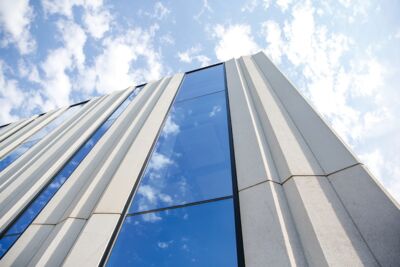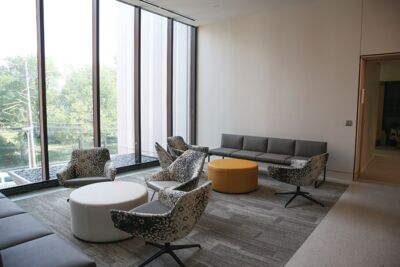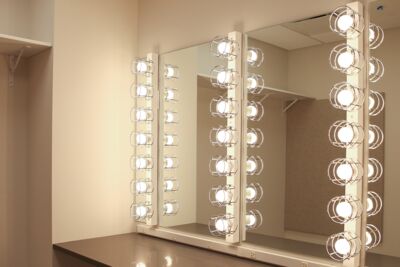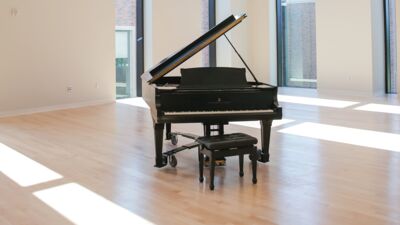
A New Composition
Story: Robert Cody ’14
Photos: Liz Kucera, Courtesy of Robert Cody and Dr. Kurt von Kampen
Concordia’s new Borland Center for Music and Theatre will be a space for inspiring creativity, sharing talents and proclaiming the Gospel of Christ.
While the skyline, footprint and modernity of this space may have changed, its mission and purpose have not.
Robert Cody is Concordia’s newest assistant professor of music. He is the conductor of the University Concert Band and other instrumental ensembles.
Concordia students of decades past likely recall with ease the sights and sounds of the music building before April 19, 2021 (the day it closed for its most recent renovations). The glass door entrance opened to the rhythms of a babbling koi pond; distant calls of voices, horns and organs; conversations between friends and colleagues; or the buzzing quiet in the closing hours of the night when, by chance, all others had left and the instruments stood silent. The suspended silver sculpture spun silently over the murmuring waters the koi called home. Towering windows ushered in the light of day and dark of night, standing as a canvas for the grand divergent staircase. For we who spent our hours there, those sights and sounds evoked sentiments of home and memories of trials and triumphs, a resting place for some of our dearest memories. Now, as the last of the floors are finished, paint sprayed and carpet laid, those sights have become memories as we behold the next chapter of music and theatre at Concordia.
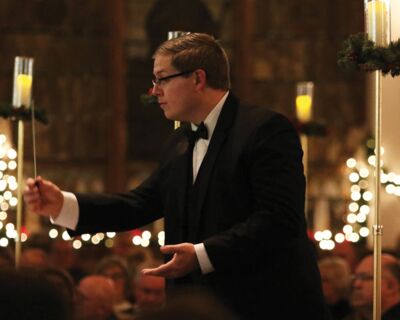
The Borland Center for Music and Theatre’s 46,544 square feet of intentionally-planned, expertly crafted, state-of-the-art halls and walls lay in wait to welcome those for whom it was built: the God-gifted, talent-laden, hard-working students of the Concordia music and theatre programs. The renovated and newly constructed spaces together boast 22 practice rooms, pristine and aesthetically peerless instrumental and choral rehearsal spaces, universal acoustic treatment, a new 100-seat black box theater, continuous ground-to-roof windows, a full-scale and expertly outfitted recording studio (all of which are now fully accessible) and yes, even a new koi pond. With these and many more optimal developments, the Borland Center tips its hat to that which made the bygone music building so dear—and immeasurably surpasses its stature and features in preparation for the future of music at Concordia. The capacity for learning will be exponentially multiplied as building-wide technology is updated and integrated. As studios increase in size and number, the collaboration possibilities become endless. The Borland Center escalates the capacity for the sheer quantity of students to not only attend classes and rehearsals, but to learn more efficiently, effectively and enjoyably.
And yet, as the students, scores and scripts return from their exile to behold the “promised land” for which they have so patiently waited, it is fitting to take pause and give thanks and glory to our Lord, from whom all blessings flow. While the skyline, footprint and modernity of this space may have changed, its mission and purpose have not. Every hour in every practice room; every ring of a bell, each call of the Casavant ranks, line memorized, note read and pencil mark etched have always been and will continue to be done to give glory to the One who made both us and the very air that moves in sonic praise. As the evening light gleams through the vast windows and the recital hall rings in acoustic perfection, our focus is drawn to the perfect Savior. Through our pursuit of excellence, may our Concordia family and audiences across the nation and world hear one resounding refrain, Christ’s proclamation that, “It is finished.”
Quality and Sound
Story: Danielle Luebbe
Steinway pianos are considered by the vast majority of musicians to be the world’s finest pianos. They are made from the very best materials by highly skilled craftsmen who meticulously design and construct each instrument.
“For generations, Steinway has had a reputation for unsurpassed quality and sound,” said Dr. Elizabeth Grimpo, professor of music. “The pianos are truly beautiful. Each one is a work of art that allows musicians to achieve the highest degree of artistry.”
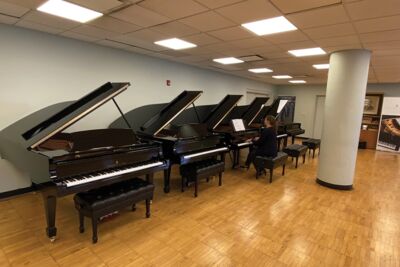
Concordia Nebraska has embarked on a journey to join a prestigious list of approximately 200 All-Steinway Institutions around the world, and only the second in the state of Nebraska. The goal is to eventually have only Steinway pianos for practice and performance, to provide students with the best instruments so they receive the best music education possible.
“We want our students to reach the pinnacle of their potential - this requires the combination of excellent musicianship and excellent instruments,” said Grimpo. “Why? To honor God with the very best and to bless others along the way.”
“Completing the Steinway Initiative will give assurance that our students will always have a quality instrument on which to practice and perform,” agreed Dr. Kurt von Kampen, chair of the music department.
Recently, von Kampen and Grimpo journeyed to the Steinway factory in New York to select the latest instrument that will find a home at Concordia, a 7-foot Steinway B grand piano. They were accompanied by Andy Hartmann and his wife, Deborah (Dee) Saucier, the generous donors who purchased the piano for the music department. Andy’s parents, Bill and Doris Hartmann, started this legacy in 2020 when they donated a 9-foot Steinway concert D grand piano in 2020.
“It was important for them to see how these instruments are made and observe the level of craftmanship and detail that goes into creating each instrument,” said von Kampen. “It is truly an amazing process.”
The Steinway Initiative is one that aligns with the mission of Concordia, he said. “The idea of cultivating a community of academic excellence means, in part, that we need to provide the proper equipment for our students.”
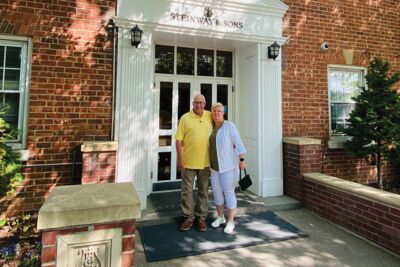
Creating Beautiful Music
Story: Brooke Lange ’24
Avery Rothert got into music education because of the people. She is from Kansas City and just finished her freshman year at Concordia. “I started as a music education major at Concordia, because as I grew up, I realized that most of the people who had the greatest impact on my life were music teachers.”
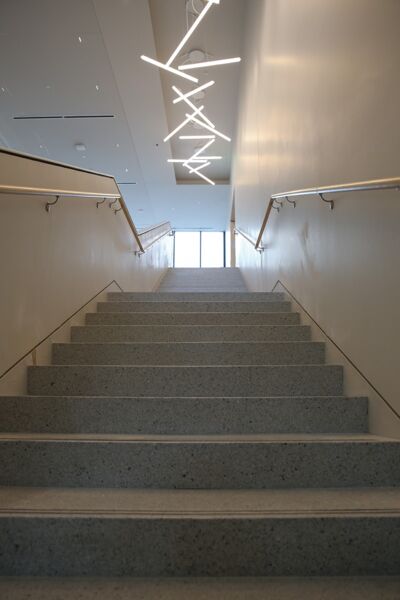
At Concordia, Avery Rothert has experienced the importance of a community of people in music firsthand, partially because of the prolonged construction on Concordia’s music building. Construction began in Spring of 2021, and it is marked to be completed more than two years later, in summer of 2023.
Throughout the years, practice rooms have spread to local churches, dorm basements, rooms in campus guest housing, and occasionally, even outdoors. “One time, I practiced a duet with someone at the outdoor chapel,” Rothert said. “We’ve definitely had to get creative with the spaces we use.”
Student recitals have also spread to different places, but that has not stopped Rothert’s enjoyment and appreciation for them. “It is amazing to celebrate what other students are working on in their private lessons, and also getting to share my own music with others.”
Even though Rothert has enjoyed the opportunity to get creative with the spaces used for practicing music, she is looking forward to the new building. ”I am really excited to have all of the music in one place, as this will be so much more convenient than walking around campus. I’m sure the acoustics will be beautiful.”
But Avery’s favorite aspect of the music department doesn’t have anything to do with the building. “My favorite part about Concordia’s music department is the Christ-centered community that we get to make music with. It is such a blessing to talk to people about how the Christian faith intersects with creating beautiful music.”
